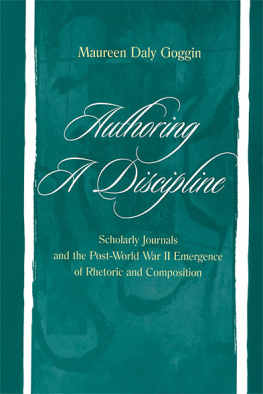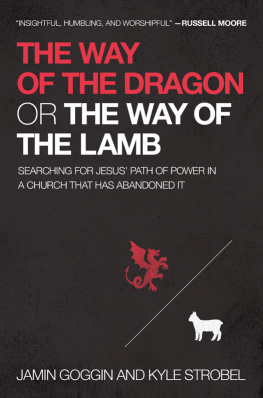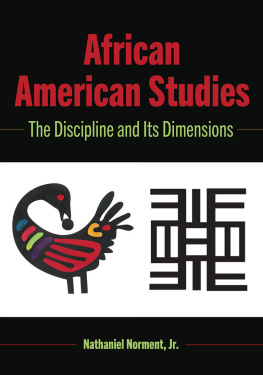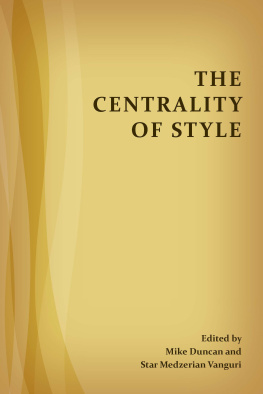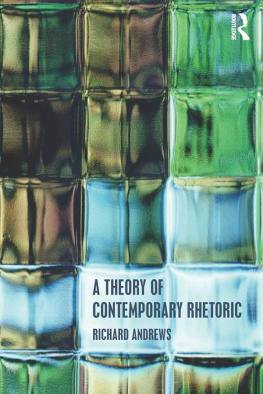Copyright 2000 by Lawrence Erlbaum Associates, Inc.
All rights reserved. No part of this book may be reproduced in any form, by photostat, microfilm, retrieval system, or any other means, without prior written permission of the publisher.
Lawrence Erlbaum Associates, Inc, Publishers
10 Industrial Avenue
Mahwah, NJ 07430
This edition published in the Taylor & Francis e-Library, 2008.
To purchase your own copy of this or any of Taylor & Francis or Routledges collection of thousands of eBooks please go to www.eBookstore.tandf.co.uk.
Cover design by Kathryn Houghtaling Lacey
Library of Congress Cataloging-in-Publication Data
Goggin, Maureen Daly.
Authoring a discipline: scholarly and the post-World War II emergence of rhetoric and composition/Maureen Daly Goggin.
p. cm.
Includes bibliographical references and index.
ISBN 0-8058-3578-4 (cloth: alk. paper)
1. English languageRhetoricStudy and teachingHistory20th century. 2. English languageRhetoricStudy and teachingUnited StatesHistory. 3. Periodicals. Publishing ofUnited StatesHistory20th century. 4. Scholarly publishingUnited StatesHistory20th century. 5. Academic writingStudy and teachingHistory20th century. 6. Academic writingStudy and teachingUnited StatesHistory. I. Title.
PE1405.U6 G54 2000
808'.071'17309045dc21 00025012
CIP
ISBN 1-4106-0613-9 Master e-book ISBN
ISBN13: 978-1-4106-0613-6 Master e-book ISBN
ISBN13: 978-1-135-65850-2 ePub ISBN
For Peter
CONTENTS
FlGURES AND TABLES
FIGURES
| FIG. 1.1. | Timeline: Evolution of the entrance exam in English and of composition at Harvard University. |
| FIG. 1.2. | Journals founded in rhetoric and composition, 19501990. |
| FIG. 2.1. | Proportion of conference papers published in CCC, 19501990. |
| FIG. 2.2. | Proportion of conference papers published in CE, 19501990. |
| FIG. 3.1. | First editorial policy and submission guidelines for CCC, 1965. |
| FIG. 5.1. | Geographical distribution across academic institutions, MLA members, and rhetoric/composition contributors. |
| FIG. 5.2. | Institutional affiliation of contributors to all journals, 19501990. |
| FIG. 5.3. | Contributors affiliated with four-year colleges, 19501990. |
| FIG. 5.4. | Contributors affiliated with two-year colleges, 19501990. |
| FIG. 5.5. | Distribution of contributors listing a department other than English. |
| FIG. 5.6. | Gender of contributors to all journals, 19501990. |
| FIG. B.1. | CCCC chairs, 19492000. |
TABLES
| TABLE 4.1. | Circulation Figures for Journals, 199293 |
| TABLE 5.1. | Three Generations of Editors by Graduate Degree, Institution, and Dissertation Title |
| TABLE 5.2. | Academic Rank of Contributors, 19501990 |
| TABLE 5.3. | Percentage of Female Contributors Published in Each Journal by Year |
| TABLE 5.4. | Scholarly Production, 19501990 |
| TABLE A.1. | Editors of College Composition and Communication, 19501997 |
| TABLE A.2. | Editors of College English, 19501997 |
| TABLE A.3. | Editors of Research in the Teaching of English, 19671997 |
| TABLE A.4. | Editors of Rhetoric Society Newsletter, 19681975 and Editors of Rhetoric Society Quarterly, 19761997 |
| TABLE A.5. | Editors of Freshman English News, 19721997 |
| TABLE A.6. | Editors of Journal of Advanced Composition, 19801997 |
| TABLE A.7. | Editors of Pre/Text, 19801997 |
| TABLE A.8. | Editors of Rhetoric Review, 19821997 |
| TABLE A.9. | Editors of Written Communication, 19841997 |
PREFACE
The rhetorician must know more about history, and the historian must know more about rhetoric.
Everett Lee Hunt (173)
This book traces the post-World War II emergence of rhetoric and composition as a discipline within departments of English in U.S. institutions of higher education. It examines the disciplinary formation through the lens of one of the most important vehicles for this field, its scholarly journals. Covering a forty-year span between 1950 and 1990, this history treats some of the complex struggles in which scholars and teachers have engaged to stake a ground and construct a professional and disciplinary identity. In short, this book identifies major debates and controversies ignited as the discipline emerged, traces issues and principles that have been foregrounded, and analyzes how those who directed the journals and those who contributed to them helped to shape, and in turn were shaped by, the field of rhetoric and composition.
As is now commonplace for historians, let me say this is not the history of the disciplinary formation but one story of many to be told. It is perhaps easier to say what a book is not rather than what it is, the temptation simply to retell its story being too great. Here then is what this book is not. First, this is not a history of writing instruction. Many excellent histories have been, and are still being, written about this important part of our past and present. Among the more recent exemplars are Robert Connorss Composition-Rhetoric, Sharon Crowleys Composition in the University, Joseph Harriss A Teaching Subject, and John Breretons The Origins of Composition Studies in the American College, 18751925. These have taken their place alongside the foundational book-length histories by Albert Kitzhaber, Arthur Applebee, James Berlin, Nan Johnson, Susan Miller, and David Russell. Second, this is not an intellectual history or a history of ideas. Fine histories in this vein have been written. Among them, Martin Nystrand, Stuart Greene, and Jeffrey Wiemelt provided an excellent account of some of the various schools of thought that have influenced the intellectual zeitgeist not only of rhetoric and composition but also of linguistics and literary studies since 1950. In Rhetoric and Reality, James Berlin presented an important account of various rhetorical theories and their associated pedagogies in his effort to map the terrain of writing instruction in the 20th century. Stephen North, in The Making of Knowledge in Composition, offered a useful classification of knowledge-making communities of researchers, scholars, and teachers. Finally, unlike the excellent treatments of particular institutions (Varnum), specific individuals (Campbell; Maher; Stewart and Stewart), or particular practices (Gere; LeFevre; Trachsel) that have influenced our more recent history, this book focuses more broadly on the institutionalization of rhetoric and composition as a discipline but at the same time more narrowly on its major scholarly journals. It traces changes in objects of inquiry, methodologies, and discourses; shifts in the identities of contributors and editors, and in editorial policies and practices to demonstrate how a discipline both responds to and is shaped by a confluence of forces. More specifically, it shows how journals, as one legitimating instrument of disciplinarity, function in a dialectical relation with a discipline.

